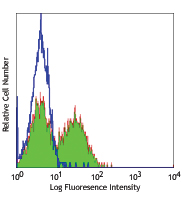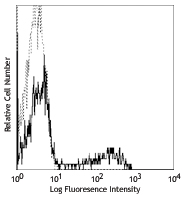- Clone
- 9E2 (See other available formats)
- Regulatory Status
- RUO
- Other Names
- NKp46, NCR1
- Isotype
- Mouse IgG1, κ
- Ave. Rating
- Submit a Review
- Product Citations
- publications

-

Human peripheral blood lymphocytes stained with purified 9E2, followed by anti-mouse IgG FITC
| Cat # | Size | Price | Quantity Check Availability | Save | ||
|---|---|---|---|---|---|---|
| 331902 | 100 µg | 104€ | ||||
CD335, also known as NKp46, is a member of the natural cytotoxicity receptor (NCR) family which triggers cytotoxicity in NK cells. CD335 is directly involved in target cell recognition and lysis, and is exclusively expressed on CD3-CD56+ NK cells, suggesting it is a universal marker for NK cells. NKp46, along with NKp30 and NKp44, is referred to as a natural cytoxicity receptor (NCR) and plays a very important role in killing virus-infected tumor cells and MHC-class I-unprotected cells.
Product DetailsProduct Details
- Reactivity
- Human
- Antibody Type
- Monoclonal
- Host Species
- Mouse
- Immunogen
- NKp46-Fc fusion protein
- Formulation
- Phosphate-buffered solution, pH 7.2, containing 0.09% sodium azide.
- Preparation
- The antibody was purified by affinity chromatography.
- Concentration
- 0.5 mg/ml
- Storage & Handling
- The antibody solution should be stored undiluted between 2°C and 8°C.
- Application
-
FC - Quality tested
- Recommended Usage
-
Each lot of this antibody is quality control tested by immunofluorescent staining with flow cytometric analysis. For flow cytometric staining, the suggested use of this reagent is ≤0.125 µg per million cells in 100 µl volume. It is recommended that the reagent be titrated for optimal performance for each application.
- Application Notes
-
Clone 9E2 has been shown to block NK activation through NKp46.6
- Application References
- Product Citations
- RRID
-
AB_1027637 (BioLegend Cat. No. 331902)
Antigen Details
- Structure
- Type I membrane glycoprotein (46 kD)
- Distribution
-
Expressed on resting and activated NK cells
- Cell Type
- NK cells
- Biology Area
- Immunology, Innate Immunity
- Molecular Family
- CD Molecules
- Antigen References
-
1. Mandelboim O and Porgador A. 2001. Int. J. Biochem. Cell Biol. 33:1147.
2. Nakajima H, et al. 2000. Eur. J. Immunol. 30:3309.
3. Sivori S. 1999. Eur. J. Immunol. 29:1656. - Gene ID
- 9437 View all products for this Gene ID
- UniProt
- View information about CD335 on UniProt.org
Customers Also Purchased
Compare Data Across All Formats
This data display is provided for general comparisons between formats.
Your actual data may vary due to variations in samples, target cells, instruments and their settings, staining conditions, and other factors.
If you need assistance with selecting the best format contact our expert technical support team.
 Login / Register
Login / Register 












Follow Us